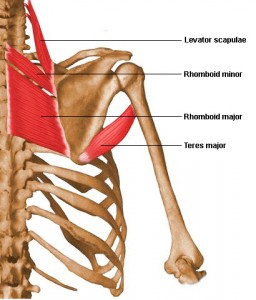 Almost everyone I meet thinks that they are round-shouldered.
Almost everyone I meet thinks that they are round-shouldered.
If you fall into this category it is highly likely that your rhomboid muscles are one of the issues. Loose or weak rhomboids are a vexing problem.
Rhomboid major and rhomboid minor, connect the shoulder blades and therefore the shoulder girdle to the spine.
The main problem with the Rhomboids and posture, as well as the yoga practice, is a lack of attention to exercises that specifically engage and strengthen the rhomboids.
Our classic way of standing up straight, lifting our chests and throwing our shoulders back puts the rhomboids into a position that they would like to be living in without having to exert any effort.
There is an ideal resting length for each muscle and artificially placing a muscle in its ideal length doesn’t really accomplish what specific exercises meant to build strength would.
The rhomboid major attaches along the medial spine of the shoulder blade and then connects to the thoracic spine on the 2nd through the 5th vertebrae.
Rhomboid minor arises from the spinous processes at the base of the neck (cervical spine) and the top of the upper back (thoracic spine).
It is inserted into a small area in the middle of the inner edge (the spine) of the scapula.
Because the rhomboids unite the shoulder girdle with the spine the tone of these muscles determines a great deal of balance in the complex of the head neck and shoulder.
Ideally the rhomboids and another muscle, teres major, form a sling that stabilizes the movement of the lower part of the shoulder blade.
When Rhomboids lose their tone and can’t balance with teres major or stabilize the scapula, the function of supporting the shoulder girdle passes to the spinal muscles, which are meant to be extensors or erectors of the spine.
Another problem is if the Rhomboids are weak and the scapula wings out, the head of the humerus (arm) is permanently turned in which relates to tightness in the pectoralis minor.
We often get into a chicken-and-egg situation—do weak Rhomboids lead to tight pectorals or do tight pectorals lead to weak rhomboids?
Finally, I love to write about the psoas at any opportunity so here is an interesting psoas/ rhomboid connection.
Whereas the psoas major sort of straps the pelvic girdle to the legs and spine in the front of the body, the rhomboids connect the shoulder girdle to the spine at the back.
***
